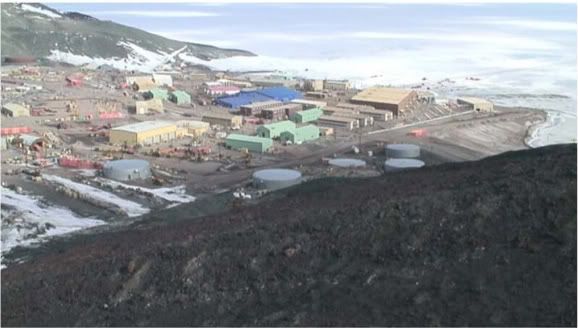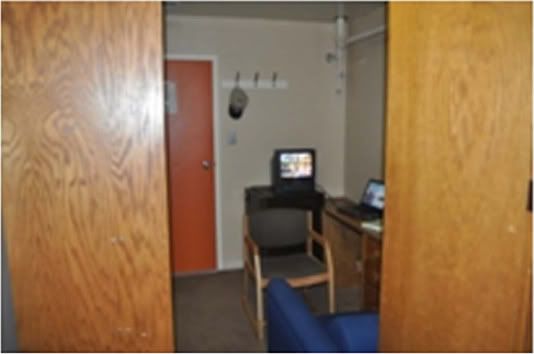We are done with the riskiest part of the project—opening the radome and destacking/restacking the antenna.
My initial optimism at the end of the last post was crushed by the weather here. On December 4th, based on observed winds Lift #2 (Radome uncapping) we dismissed the crane operators and ESSCO before even going up the hill. The winds were blowing and reached a gust of 56mph. Sunday 12/5, the winds were worse and hit 67 mph in one gust up on the hill–very little got done that weekend. On Monday 12/6, the weather forecast was for winds to die down today. They did not.
Based on our wind observations we decided to start work just after midnight on Tues. 12/7, the winds had usually lower between midnight and 7am. Since the Galley offered, midrats at midnight we took advantage of this to have this as our breakfast. As it is daylight 24 hours/day till the next subset on 2/20/11, we wear sunglasses at night.
We went up the hill at 12:30am on the 7th. This worked well and we made the critical lifts of the radome cap and the antenna reflector with no problems at all. RPSC/Bill Gollehon operated the crane and made both these picks look easy, but they weren’t. The radome cap and the reflector are relatively light, 3600 lbs. and 5800 lbs. respectively with a large surface area—in other words they make great sails.

The radome cap coming off |
|
The reflector clear of the radome
|
With the radome cap and the reflector secured by tying each down to a series of large concrete blocks to ensure the wind doesn’t cause catastrophic damage to them.
|
|
The radome cap about to placed for storage
|
| The rest of the long morning went well and we quickly finished four more lifts and transferred the antenna dish support arms to the new pedestal. |
|
Removing the one of two counterweights
|
|
Removing old pedestal assembly
|
|
Removing old train assembly
|
|
It was approaching noon, the winds were picking up, the guys were tired so we stopped lift operations and ESSCO proceeded to brace the open radome while Datron used the crane to install the new X-band feed.

New X-band feed (vertical tube in reflector) |

Me between lifts |
All the day’s activities had gone extremely well and the weather forecast showed winds on the 8th to be in the 8-18 mph range we were pretty confident we could finish the next day. We were wrong.
The winds were low on the 8th just before 1am and the lift of the new train into the radome went smoothly until the bolt holes were lined up, and well didn’t align. HTSI/William Kambarn and Datron/Steven Sciacca spent thirty or more minutes trying to align the wholes and insert the bolts to no avail. The bolt hole pattern on the new assembly was slightly larger than the diameter of the bolt hole pattern on the pedestal riser. Several solutions were proposed but the use of smaller hardened bolts was selected as the most advantageous, given the limited resources at McMurdo and the need to close the radome ASAP. HTSI personnel located a source at McMurdo for the bolts needed. The bolts located were too long to allow tightening the Train assembly to the pedestal riser. However, a RPSC machinist stayed late to manufacture a spacer for each bolt so that they could be used. They will be replaced one at a time after replacements arrive, but this allowed us to continue the next morning.
Again we went up the hill after midnight to begin a new work day on the 9th. I was very relieved when the new pedestal went on without a hitch.

Datron/ Steven Sciacca (right) tightens a smaller temporary bolts and is assisted by HTSI/ William Kambarn
|
The lifts of the counterweights went well, but because the way the hung, it was very difficult and time consuming to mount them back on the pedestal. However, later that morning we were able to lift the reflector and reattached it to the pedestal.
|
The first counterweight being installed
|
|
The reflector being reattached
|
Again, as it approached noon, the winds picked up and we had to abort recapping the radome when the cap began to oscellate from the wind gusts. Again, we called it a day and planned for another 1am start.
The 10th the wind was marginal for the lift but at least it was steady. As you can see below the wind can have a significant effect on a 3,600 lbs. sail.
|
Lifting the Cap
|
|
Lowering the cap back on to the radome
|
|
Preparing to complete the attachment of the cap to the radome structure
|
It took ESSCO several hours to complete fastening all the bolts but by lunchtime they had completed it and we were done for the day!





























